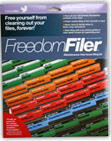Do you embrace the words “priorities” and “goals”, or do they fill you with fear?
Are you afraid that if you took a long look at where your time is spent, you would be disheartened and disillusioned? You can’t see the merry-go-round of life slowing down, so you keep on running as fast as you can?

Credit: David Salafia/Flickr (CC-ND)
We Americans tend to fill our lives with so much clutter that we cannot see what is truly important. Even our children have sports and music lessons and are going in so many different directions that the parents have to go separate ways on the weekends to make it all happen.
The same principles that professional organizers use to help people dig out from under all the extra “stuff” can be applied to life choices as well. Rather than use the terms “priorities” and “goals”, think about going on a treasure hunt.
Priorities and goals: a treasure hunt
What are the top three “treasures” in your life; what do you value most? Some answers that come to mind are: family, spiritual life, making a difference, financial security, health. Write down your top three.
Now honestly evaluate your attitudes (the way you think) and your activities (the things you do) based on what you have just said are the most important things – the “treasures” – in your life. How do your attitudes and activities line up?
Treasure your priorities
This is the sorting stage of organizing. Putting the like things together and seeing “What you really have!” Sometimes just looking at your life clutter in the light of day is enough to toss some things.
Next is the painful part – purging. There may even be some good things in your life that must go to make room for the best. We all have the same 24 hours per day. After sleeping that amounts to 960 minutes. If you have a full-time job, only half of that is discretionary – 480 minutes per day.
Where do you want to invest your time and energy so that you are true to your values?
Get off the merry-go-round
There are more steps to the organizing process, but we will stop at this third one: assigning a home. Where in your life schedule will you make a place for the people, attitudes and activities you have identified as your treasures? Make appointments with yourself and others that honor your decisions.
One of my favorite childhood songs is titled “Horace the Horse”. Horace is a horse on the merry-go-round, always going up and down, round and round. He is sad because he is the very last horse, always following others. Then one day he looks around and says, “Gosh! Oh gee! I’m the very first horse on the merry-go-round, ’cause the others are a’followin’ me!”
Home is where your heart is
Your attitude, your decisions can influence the lives of others in profound ways when you take the initiative to identify what is truly of value and determine to follow your own path.
![]() I have helped quite a few clients set up this system in their home to corral paper so they can find what they are looking for in 10 seconds or less. It’s kind of a “no brainer”. You purchase, set it up like in the picture, and it is so easy to use you don’t have to think. Love saving those little grey cells…
I have helped quite a few clients set up this system in their home to corral paper so they can find what they are looking for in 10 seconds or less. It’s kind of a “no brainer”. You purchase, set it up like in the picture, and it is so easy to use you don’t have to think. Love saving those little grey cells…


 There are a few tricks that interior designers and professional organizers alike use to maximize storage in a truly small space.
There are a few tricks that interior designers and professional organizers alike use to maximize storage in a truly small space.
